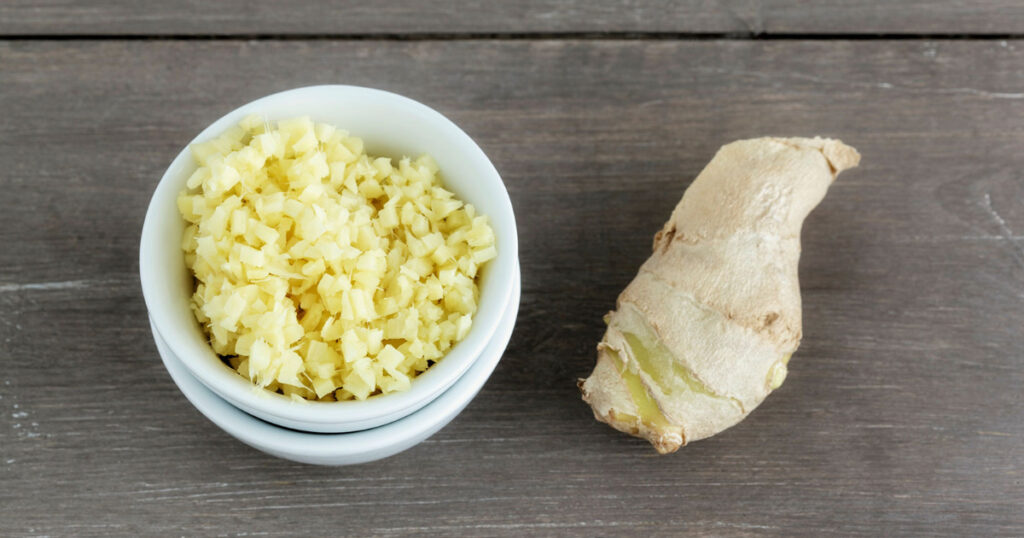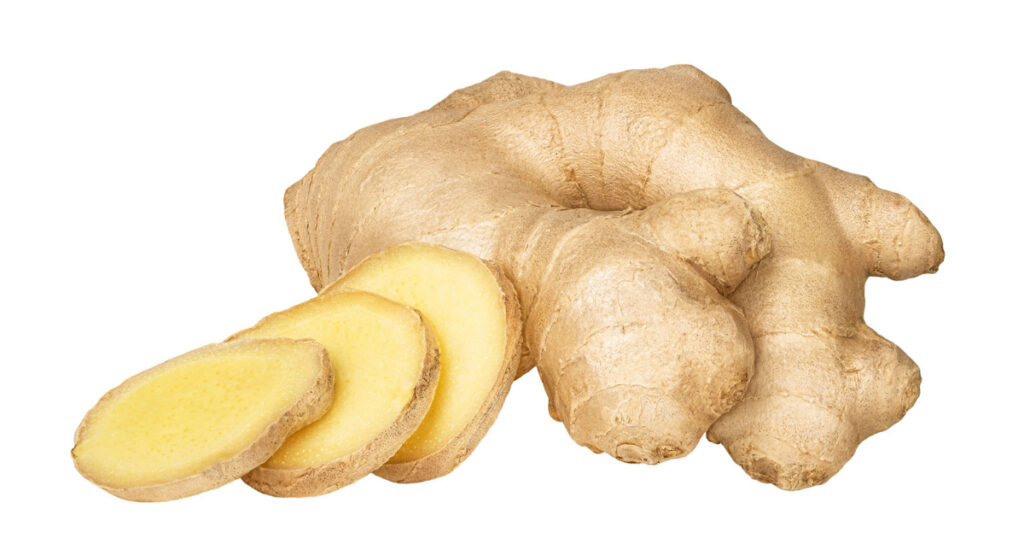Ginger is a versatile and aromatic ingredient used in cuisines around the world. The spicy, pungent flavor of ginger adds a special kick to both sweet and savory dishes. When shopping, you’ll typically find ginger available fresh or pre-minced and dried. But what’s the difference between these two main forms of ginger?
We’ll explain everything you need to know about minced and fresh ginger. Discover how they compare in taste, texture, shelf life, preparation, health benefits and best uses. Let’s discover the key distinctions between these two ginger consistencies so you can decide which is best for your needs.
What is Minced Ginger?

Minced ginger has been finely chopped, diced, or grated into tiny pieces or grains. The mincing process helps release the oils and intensify the ginger flavor. Minced ginger is often dried or dehydrated after chopping, which further concentrates the ginger taste.
Dried minced ginger has an intense, spicy flavor since the water is removed during drying. The little minced ginger bits pack a real punch! Some minced ginger is sold already rehydrated in water or syrup. But most minced ginger products are fully dried.
When purchasing dried minced ginger, look for pieces that are beige or light brown in color. They should be dry but still somewhat pliable. Avoid any pieces that are hard, dark, or shriveled up. Properly stored dried minced ginger will maintain optimal flavor and potency for up to 1 year.
To use dried minced ginger, you first need to reconstitute it by soaking the pieces in hot water for about 15 minutes. This allows the ginger to reabsorb moisture and become softened again. After soaking, use the hydrated minced ginger immediately for the most robust ginger taste.
Rehydrated minced ginger is perfect for blending into sauces, curries, soups, and anywhere you want an intense ginger flavor without the fibrous texture of fresh ginger. The smaller pieces infuse faster and more efficiently than freshly grated ginger.
What is Fresh Ginger?

In contrast to dried minced ginger, fresh ginger is just the plain raw ginger root freshly harvested from the ginger plant. It has a tan rough outer skin that needs to be peeled off before use. The inner flesh is pale yellow with a fibrous, stringy texture.
Fresh ginger has a pleasantly spicy earthy flavor when eaten raw. It is also used cooked in both savory and sweet dishes. The ginger taste is milder compared to minced ginger. But it gives a refreshing ginger flavor pop when added raw.
Look for plump, firm ginger roots without wrinkles, mold or soft spots when buying fresh ginger. Unpeeled ginger can be stored in a paper bag in the refrigerator crisper drawer for 2-3 weeks. To freeze fresh ginger for longer storage, peel first then grate it. Frozen grated ginger can keep for up to 6 months.
Fresh ginger is conveniently used straight from the root. Peel first then it can be minced, sliced, julienned, or grated as needed for cooking. Raw applications like smoothies or stir fries benefit from the lively ginger zing.
Key Differences Between Minced and Fresh Ginger
There are some notable differences between using minced ginger versus fresh ginger.
Here are the main distinguishing characteristics:
- Flavor intensity – Minced ginger has a stronger, more concentrated flavor while fresh ginger is milder in taste.
- Texture – Rehydrated minced ginger has a soft, tender texture. Fresh ginger is naturally fibrous and crisp.
- Preparation – Fresh ginger needs to be peeled first. Minced ginger just needs soaking.
- Shelf life – Properly stored, minced ginger lasts about 1 year. Fresh ginger lasts 2-3 weeks.
- Uses – Minced ginger works better cooked for long periods. Fresh ginger adds a fresh pop of flavor when added at the end.
Culinary Uses for Minced and Fresh Ginger
How to Use Minced Ginger
Due to its intensely spicy ginger flavor when rehydrated, minced ginger shines in these uses:
- Baked goods – The concentrated flavor of minced ginger makes it ideal for flavoring gingerbread, cookies, cakes and other baked treats.
- Beverages – Minced ginger can be steeped into hot water for a warming ginger tea. It’s also excellent for making ginger ale and ginger beer.
- Stews and soups – Add rehydrated minced ginger early in the cooking process for deep ginger flavor infusion.
- Curries – Combine with other dried spices like coriander, cumin, chili powder for extra dimension.
- Marinades and rubs – First rehydrate the minced ginger, then blend into wet or dry spice mixes.
- Desserts – Use minced ginger to add a spicy kick in puddings, custards, frozen yogurt, even ice cream!
How to Use Fresh Ginger
The mild brightness of fresh ginger makes it ideal for:
- Stir fries – Grated ginger added just before serving gives a fresh ginger spike.
- Smoothies and juices – Blends well with fruits and vegetables for a zesty flavor boost.
- Salads – Grate fresh ginger over salads and slaws right before serving.
- Pickling – Adds a nice bite to pickled vegetables or fruits.
- Dressings and sauces – Grate into oil and vinegar dressings, soy sauce, teriyaki.
- Garnishes – Freshly grated ginger on noodles, rice, veggies or meats.
- Tea – Sliced ginger steeped in hot water makes a tummy-soothing tea.
Health Benefits of Ginger
Both fresh and minced ginger provide a range of potential health benefits thanks to their content of the active compound gingerol.
Here are some science-backed ways ginger may support wellness:
- Anti-inflammatory – Gingerol acts as a natural anti-inflammatory agent in the body when consumed regularly. This can help relieve joint pain or inflammatory conditions.
- Digestive aid – Ginger has long been used to settle nausea, vomiting, motion sickness and other uneasy digestive issues. Studies show ginger can ease stomach discomfort.
- Immunity boost – Ginger’s antimicrobial properties may help strengthen the immune response and prevent illnesses. Gingerol exhibits antioxidant activity as well.
- Respiratory relief – Ginger is a traditional remedy for coughs and colds. The compounds may help clear up chest congestion.
- Cancer prevention – Some research indicates ginger may have potential to combat certain cancer cells and tumors, though more study is needed.
How to Store Ginger Properly
To get the most shelf life and flavor from ginger, use these proper storage methods:
Storing Minced Ginger
- Store dried minced ginger in an airtight glass jar or container.
- Keep in a cool, dark cupboard away from light, heat and moisture.
- Refrigerating extends the shelf life even longer.
- With optimal storage, dried minced ginger keeps for up to 1 year.
Storing Fresh Ginger
- Unpeeled – Place whole fresh ginger roots in a paper bag in the crisper drawer of the fridge. Keeps 2-3 weeks.
- Peeled – Store peeled ginger submerged in water in a container in the fridge, changing water daily. Lasts 1 week.
- Frozen – Peel and grate fresh ginger, then freeze for up to 6 months.
Proper storage preserves the flavorful oils and active compounds in your ginger. Follow these tips for ginger that keeps you satisfied!
Conclusion
In the battle of minced ginger vs fresh ginger, both have their strong points. Minced ginger offers intensely spicy flavor that amplifies baked goods and braised dishes. Mild fresh ginger brightens up raw preparations with its freshness.
Minced ginger needs to be reconstituted first, so it works best cooked. Fresh ginger is ready to use immediately for a livelier flavor. Both provide antimicrobial, anti-inflammatory and digestive health benefits thanks to their gingerol content.
With optimal storage methods, minced ginger can last up to 1 year, while fresh ginger keeps for 2-3 weeks. For a bold spicy ginger kick, go with minced. For a gentle fresh zing, choose fresh ginger. Let your recipe and taste preferences guide you to the best type of ginger for each use.
FAQ
What’s the shelf life of minced ginger versus fresh?
With optimal storage conditions, dried minced ginger can last around 1 year, while fresh ginger lasts about 2-3 weeks in the fridge.
Is minced or fresh ginger healthier?
Both forms contain the beneficial compound gingerol and offer similar health benefits when consumed.
What dishes work best with fresh ginger?
The mild brightness of fresh ginger shines in stir-fries, dressings, marinades, and garnishes added at the end.
What’s the best way to substitute minced for fresh ginger?
Use about half the rehydrated minced ginger as you would fresh grated, since minced has a very concentrated flavor.
How do you store fresh ginger long term?
Peel and grate fresh ginger, then freeze it for up to 6 months of storage.
Can you substitute dried ginger for fresh?
Dried ground ginger can be used in place of fresh in baked goods, but not as a 1:1 substitute. Reduce the ground ginger amount and add other spices like cinnamon.
What’s the easiest way to mince fresh ginger?
Peel first, then grate the ginger on a microplane or the smallest holes of a box grater. No need to chop finely.
How do you rehydrate dried minced ginger?
Soak the minced ginger pieces in hot water for 15 minutes before use to rehydrate. Drain then use immediately for maximum flavor.
What are good uses for ginger juice?
Fresh ginger juice adds great flavor to marinades, dressings, cocktails, mocktails, and dipping sauces.
Can you freeze grated fresh ginger?
Yes, freeze freshly grated ginger in a freezer bag or airtight container for 4-6 months. It retains flavor and nutrition well.

